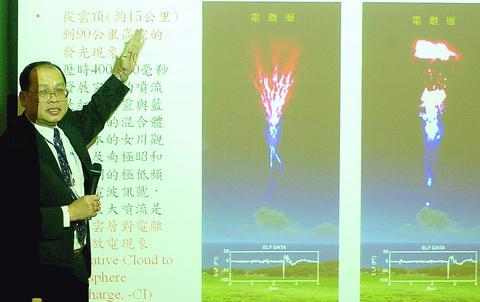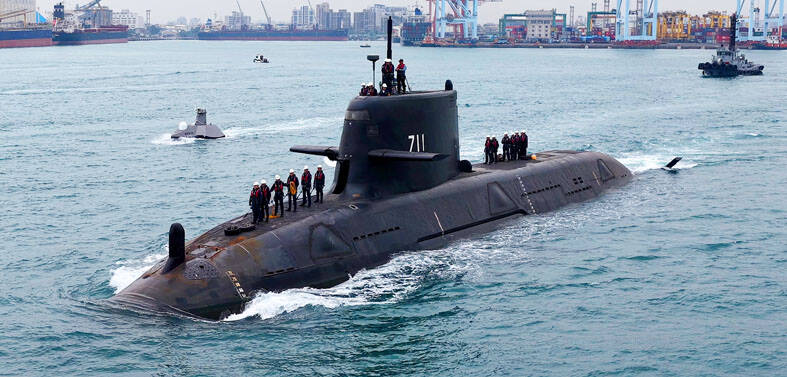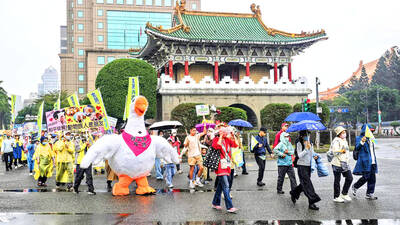Research by Taiwanese scientists on gigantic jets of lighting linking thunderclouds and the ionosphere was published yesterday in this week's edition of Nature magazine.
According to Lee Lou-chuang (李羅權), director of the council's National Space Program Office, the letter to Nature detailed the first conclusive observation data in the world indicating that a direct optical path was established from the thunderclouds about 15km above the Earth's surface to the ionosphere at the height of about 90km.

PHOTO: SEAN CHAO, TAIPEI TIMES
Lee, one of co-authors of the letter, stressed that the conventional picture of the global electric circuit needs to be modified to include the contributions of these gigantic jets and possibly sprites.
On July 22 last year, a team led by two physicists at National Cheng Kung University, Su Han-tzong (蘇漢宗) and Hsu Ruey-rong (許瑞榮), took high-resolution images of a rare "giant blue jet," which feeds energy from thunderstorms up into the ionosphere.
Researchers stationed on the southern tip of Taiwan and the university campus observed five giant blue jets, which extended from a thundercloud above the South China Sea near Luzon Island, The Philippines, to the electrically conducting ionosphere.
"A fully-developed gigantic jet optically spanned the thundercloud top at 15 km and the ionosphere at 90 km elevation," Lee said.
The upper bodies of the gigantic jets, which lasted for just 800 milliseconds, was similar to sprites, but their lower bodies resembled blue jets, Lee said.
Lee said that there was no evidence suggesting that the event was triggered by cloud-to-ground lightning. However, Lee said, extremely-low-frequency (ELF) radio waves associated with four of the five gigantic jets were detected by Japanese scientists working at stations in Antarctica and Japan.
In the last 10 years, scientists have discovered that the atmosphere above thunderclouds is not as tranquil as many people imagined.
Anecdotes told by pilots about transient luminous event have been captured by high-tech equipment since 1994. Those events have been classified into three categories: lighting-induced red sprites, upwardly discharging blue jets and gigantic jets.
The discovery of a "giant blue jet" by Victor Pasko of Pennsylvania State University in September 2001 was reported in a Nature cover story in April last year.
In 2001, a National Cheng Kung University team's images of red sprites were chosen as cover photo of Vol. 29 of Geophysical Research Letters,which was published in April last year.
"The potential of Taiwanese scientists deserved to be greatly encouraged," National Science Council Vice Chairman Hsieh Ching-chih (

NUMBERS IMBALANCE: More than 4 million Taiwanese have visited China this year, while only about half a million Chinese have visited here Beijing has yet to respond to Taiwan’s requests for negotiation over matters related to the recovery of cross-strait tourism, the Tourism Administration said yesterday. Taiwan’s tourism authority issued the statement after Chinese-language daily the China Times reported yesterday that the government’s policy of banning group tours to China does not stop Taiwanese from visiting the country. As of October, more than 4.2 million had traveled to China this year, exceeding last year. Beijing estimated the number of Taiwanese tourists in China could reach 4.5 million this year. By contrast, only 500,000 Chinese tourists are expected in Taiwan, the report said. The report

Temperatures are forecast to drop steadily as a continental cold air mass moves across Taiwan, with some areas also likely to see heavy rainfall, the Central Weather Administration (CWA) said. From today through early tomorrow, a cold air mass would keep temperatures low across central and northern Taiwan, and the eastern half of Taiwan proper, with isolated brief showers forecast along Keelung’s north coast, Taipei and New Taipei City’s mountainous areas and eastern Taiwan, it said. Lows of 11°C to 15°C are forecast in central and northern Taiwan, Yilan County, and the outlying Kinmen and Lienchiang (Matsu) counties, and 14°C to 17°C

STEERING FAILURE: The first boat of its class is experiencing teething issues as it readies for acceptance by the navy, according to a recent story about rudder failure The Hai Kun (海鯤), the nation’s first locally built submarine, allegedly suffered a total failure of stern hydraulic systems during the second round of sea acceptance trials on June 26, and sailors were forced to manually operate the X-rudder to turn the submarine and return to port, news Web site Mirror Daily reported yesterday. The report said that tugboats following the Hai Kun assisted the submarine in avoiding collisions with other ships due to the X-rudder malfunctioning. At the time of the report, the submarine had completed its trials and was scheduled to begin diving and surfacing tests in shallow areas. The X-rudder,

DEMAND: The government should enact regulations in line with Austria and Germany to incorporate vegan nutrition into school meals, an advocate said More than 1,000 people yesterday marched in Taipei to promote veganism, calling for legislation to incorporate vegan diets into school lunches and the national net zero emissions program. Participants gathered on Ketagalan Boulevard in front of the Presidential Office Building for the march, which was organized by the Vegan Action Network (VAN). Former ambassador to Chad Chiu Chung-jen (邱仲仁), actor Yankee Yang (楊子儀) and actress Cindy Lien (連俞涵) attended the event. VAN member Marianne Chao (趙梅君) said that the campaign aimed to urge the government to promote vegan diets across schools and government agencies via legislation and national policies, which would help build